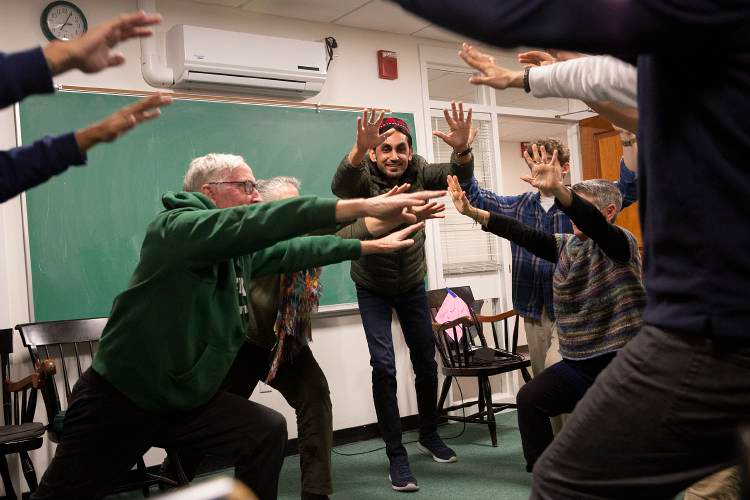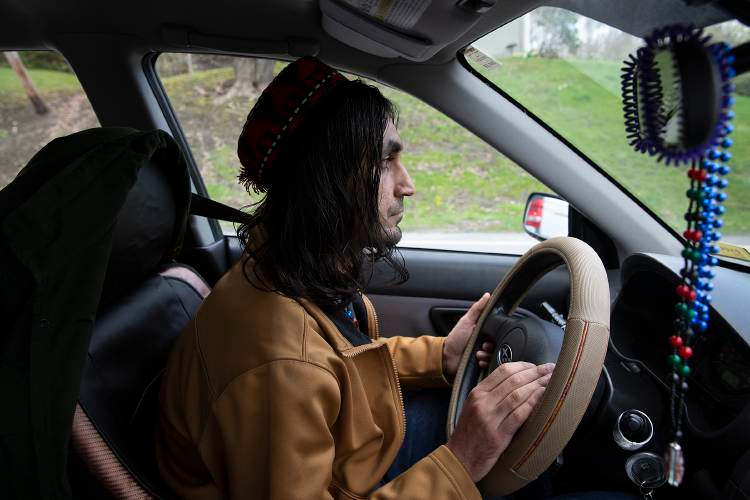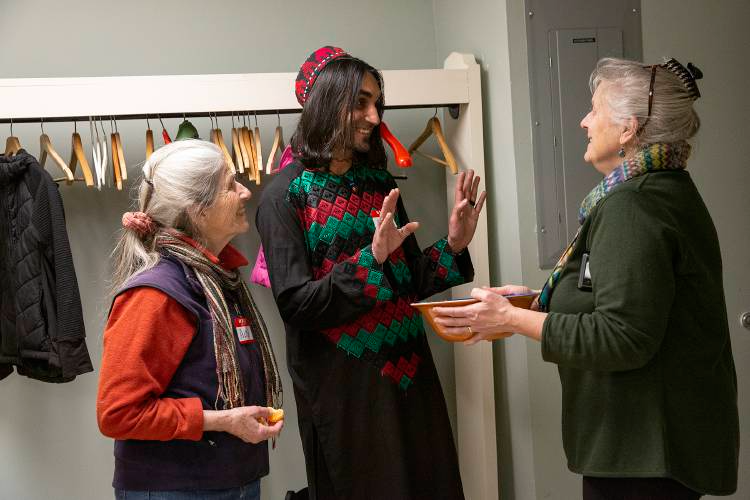Alex Driehaus talks about her career and portfolio of projects rich with empathy on this week’s episode of The Granite Beat.
By Adam Drapcho and Julie Hart, The Laconia Daily Sun
Listen to the full interview on The Granite Beat podcast
A good photographer is someone who operates their equipment with technical skill, but a great photographer is one who balances that skill with empathy for the scene and people they are photographing. On this week’s episode of The Granite Beat, we speak with Valley News photojournalist Alex Driehaus, who has a portfolio of projects rich with empathy. She has spent time photographing people recovering from addiction in Ohio, marginalized young adults in San Francisco, and most recently, a former Special Forces soldier from Afghanistan now living as a refugee in New Hampshire's Upper Valley.



Adam Drapcho:
Tell us about when you started to become interested in photography and photojournalism. What made you decide to make this your vocation?
Alex Driehaus:
When I was in high school my family moved to a country in southern Africa that at the time was called Swaziland and is now Eswatini. I joke that as a consolation prize my parents bought me a camera – a Canon Rebel T3, I think. Having that really helped me adjust to that experience. It kind of gave me an opportunity to explore the world from my viewpoint and I really fell in love with photography through that experience. I didn't ever really intend to end up in the photojournalism world, but I was trying to figure out how I could maybe turn photography into a career. The college I went to, Ohio University, had a really great photojournalism program so I thought, why not check that out. After going through that program I ended up falling in love with the journalism side of photojournalism. I really enjoy the everyday interactions that I get to have with so many different people who I would never meet in my day to day life. So that's what I really enjoy about my job. After graduation I moved to Naples, Florida to work at a paper there for a couple years, but I had always heard great things about the Valley News photography department and how much they really cared about community journalism. So when I saw they had a position open through Report for America, I applied and ended up here. It's been a really great experience.
Adam Drapcho:
You mentioned your time in Florida. I was particularly intrigued by a line in one of your online bios about photographing the python hunt. Could you tell me what it was like to experience that through the lens of a camera?
Alex Driehaus:
Yeah, absolutely. There are invasive pythons in the Everglades that have kind of taken over and decimated the small mammal and reptile populations, so the state helps fund python hunters that go out and search for the snakes in the Everglades at night. We followed one woman in particular who was so cool, I love hanging out with her. She just drives along the canals with her daughter and has this rack of lights on the top of her car, and she's just so well trained at spotting the snakes out in the water. She sees one, throws the car in park, jumps out, and grabs it with their bare hands. It was pretty incredible to watch.
Adam Drapcho:
Going back to your experience of moving to Swaziland, that's such a critical age to make such a change. How long you were over there before moving back to the United States? And when you came back, did you come back with fresh eyes for this culture in this society?
Alex Driehaus:
Absolutely. We moved there when I was 16 and I moved back for college about two and a half years later. When you move somewhere that's so different from where you grew up, you expect things to be different and you're prepared for that. But then when you come home, you're expecting everything to be how it was when you left. I think that was the most jarring part, realizing how different I had become over those couple of very important formative years, and how I just saw the place I grew up a lot differently. I think I had a lot more empathy from that situation for the people I met back home.
Adam Drapcho:
With so many of the subjects you’re drawn to, there’s a necessary balance that involves capturing very close, intimate moments with a person or a family, and then sharing that with your publication but in a way that's not exploitative of their situation. Can you tell me what you think about that? How do you approach that problem?
Alex Driehaus:
I mean, I think that is the most important consideration in photojournalism. And in journalism in general. It's really important to build trust with the people you're photographing to make sure they're comfortable with you being there, and also giving them an idea of what is going to happen with those photos. Because that's not a normal experience, to have someone come into your home that you're not familiar with to photograph things that feel pretty personal. You don't know exactly how those photos are going to be used. So I think there's a lot of trust there, with people allowing you into their space. And preparing them for how this is going to be in the paper and neighbors and friends and community members are going to see it. So allowing for a sense of informed consent there is really important.
Julie Hart:
I can imagine that might be difficult when working with marginalized groups, or when there are language barriers or cultural differences. How do you approach building that trust when you run into this problem as a photographer?
Alex Driehaus:
I think a big thing is to just come in as a person; spend time talking to people beforehand, like leaving your camera in the car or just hanging by your side the whole time. Really spending a lot of time on the front end having conversations with people and not immediately putting a camera in their face. With issues like language barriers, it really helps to find a way around that either through someone that can help you translate, or even using the Google Translate app, just to build that line of communication.
Julie Hart:
I'd like to ask you specifically about a recent project the Valley News published about Abdullah Shah, a veteran of the Afghan Special Forces who fought against the Taliban and is now living in the Upper Valley. How did you happen upon this story? And how did you dig in?
Alex Driehaus:
I saw a post on a listserv from a local nonprofit, talking about how there were some refugees from Afghanistan arriving in the area and looking for community support in a variety of ways. I thought that was really interesting, because usually refugees end up going to bigger cities that have more resources and more of an infrastructure to help them resettle. I reached out and talked to a couple people from the nonprofit, and ended up going to a community dinner where some of the people new to the area were coming and getting to know their neighbors. That was where I met Abdullah. When I met him initially he’d just gotten here and hadn't yet started going to English classes, so everything was pretty new to him. I ended up reconnecting with him about a year later, actually at the same community dinner, and ended up spending a couple months with him at a variety of things that he was doing: going to English classes, going to work with him, and I went to a couple Ramadan celebrations with him as well. I probably saw him once every other week for maybe three or four months, just trying to get a good variety of what his life looks like on a day to day basis.
Adam Drapcho:
You probably could have gone just one day and gotten a bunch of pictures and moved onto the next thing. Why do you think it was worth the investment of time to keep returning and building that longitudinal relationship with Abdullah?
Alex Driehaus:
I think just spending time with people, even if it's not taking the best photos you're going to use as your lead art every time, makes them more comfortable with you being around and you have the time to build a relationship with them – which, in turn, helps you to get better and more nuanced photos. When they get more comfortable with having you around and start telling you, I'm going to get my tires changed in a couple of days, that's something that they maybe wouldn't have brought up when you initially asked what they have going on this day. So it's just getting more into the weeds of day to day life. I think that was really important and shows a broader sense of what his life looks like here and how that's changed over time, like from when he first got here to what his life looks like now.
Adam Drapcho:
I see your position is funded by Report for America. Could you tell us how that works logistically? Why did you decide to sign on for it? What do you think grant-funded news positions mean for the future of the industry?
Alex Driehaus:
Report for America is a nonprofit organization that helps place primarily early-career journalists into newsrooms that are in under-covered areas or have under-covered communities or important beats. The way it works is that the newsroom funds a portion of the salary, Report for America funds a portion of the salary, and then they encourage the newsroom to do fundraising in the community to get some kind of community buy-in. I applied to Report for America specifically because I wanted to work at the Valley News, so it was great that it worked out that way – I'm really happy that it did. There are a lot of support mechanisms through Report for America that I wouldn't have access to in a normal staff job. All of the photographers in the cohort get together on a call every other week to share work and talk about what's going on in the photojournalism industry more broadly. I've really enjoyed having that kind of space that is still focused on photography and still focused on photojournalism, but it's also outside of my newsroom. And I do think that the funding model we have for newspapers currently is kind of in flux. It's not working as well as it did several decades ago, so I think having more of a grant-funded, community-funded news model is a useful way forward, and a way to engage the community to fund the journalism important to them without being reliant on advertising.
This article is part of The Granite Beat, a project by The Laconia Daily Sun and The Granite State News Collaborative, of which Laconia is a partner. Each week Adam Drapcho and Julie Hart, will explore with local reporters how they got some of the most impactful stories in our state and why they matter. This project is being shared with partners in The Granite State News Collaborative.
